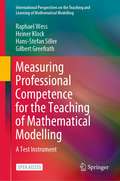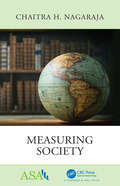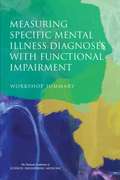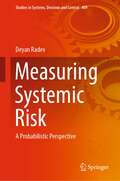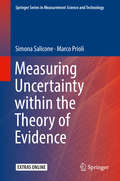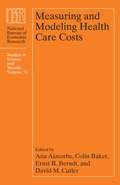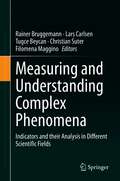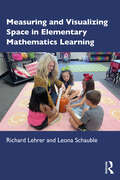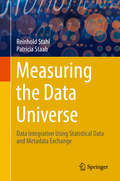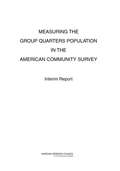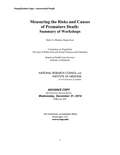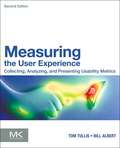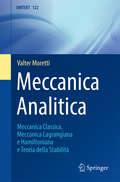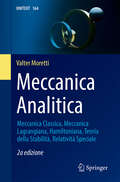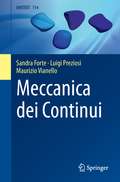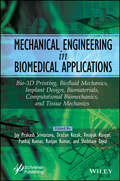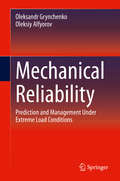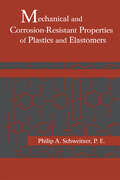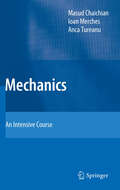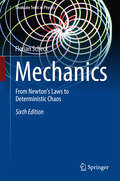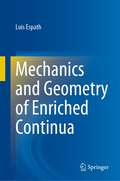- Table View
- List View
Measuring Professional Competence for the Teaching of Mathematical Modelling: A Test Instrument (International Perspectives on the Teaching and Learning of Mathematical Modelling)
by Gilbert Greefrath Hans-Stefan Siller Raphael Wess Heiner KlockThis open access book presents a structural model and an associated test instrument designed to provide a detailed analysis of professional competences for teaching mathematical modelling. The conceptualisation is based on the COACTIV model, which describes aspects, areas and facets of professional competences of teachers. The manual provides an overview of the essential teaching skills in application-related contexts and offers the tools needed to capture these aspects. It discusses the objectives and application areas of the instrument, as well as the development of the test. In addition, it describes the implementation and evaluates the quality and results of the structural equation analysis of the model. Teaching mathematical modelling is a cognitively challenging activity for (prospective) teachers. Thus, teacher education requires a detailed analysis of professional competence for teaching mathematical modelling. Measuring this competence requires theoretical models that accurately describe requirements placed upon teachers, as well as appropriate evaluation tools that adequately capture skills and abilities in this field. This book presents an instrument that measures the professional competences in a sample of 349 prospective teachers.
Measuring Society (ASA-CRC Series on Statistical Reasoning in Science and Society)
by Chaitra H. NagarajaCollecting and analyzing data on unemployment, inflation, and inequality help describe the complex world around us. When published by the government, such data are called official statistics. They are reported by the media, used by politicians to lend weight to their arguments, and by economic commentators to opine about the state of society. Despite such widescale use, explanations about how these measures are constructed are seldom provided for a non-technical reader. This Measuring Society book is a short, accessible guide to six topics: jobs, house prices, inequality, prices for goods and services, poverty, and deprivation. Each relates to concepts we use on a personal level to form an understanding of the society in which we live: We need a job, a place to live, and food to eat. Using data from the United States, we answer three basic questions: why, how, and for whom these statistics have been constructed. We add some context and flavor by discussing the historical background. This book provides the reader with a good grasp of these measures. Chaitra H. Nagaraja is an Associate Professor of Statistics at the Gabelli School of Business at Fordham University in New York. Her research interests include house price indices and inequality measurement. Prior to Fordham, Dr. Nagaraja was a researcher at the U.S. Census Bureau. While there, she worked on projects relating to the American Community Survey.
Measuring Specific Mental Illness Diagnoses with Functional Impairment: Workshop Summary
by Engineering Medicine National Academies of SciencesThe workshop summarized in this report was organized as part of a study sponsored by the Substance Abuse and Mental Health Services Administration (SAMHSA) and the Office of the Assistant Secretary for Planning and Evaluation of the U.S. Department of Health and Human Services, with the goal of assisting SAMHSA in its responsibilities of expanding the collection of behavioral health data in several areas. The workshop brought together experts in mental health, psychiatric epidemiology and survey methods to facilitate discussion of the most suitable measures and mechanisms for producing estimates of specific mental illness diagnoses with functional impairment. The report discusses existing measures and data on mental disorders and functional impairment, challenges associated with collecting these data in large-scale population-based studies, as well as study design and estimation options.
Measuring Systemic Risk: A Probabilistic Perspective (Studies in Systems, Decision and Control #409)
by Deyan RadevThis book provides a comprehensive methodology to measure systemic risk in many of its facets and dimensions based on state-of-the-art risk assessment methods. Systemic risk has gained attention in the public eye since the collapse of Lehman Brothers in 2008. The bankruptcy of the fourth-biggest bank in the USA raised questions whether banks that are allowed to become “too big to fail” and “too systemic to fail” should carry higher capital surcharges on their size and systemic importance. The Global Financial Crisis of 2008-2009 was followed by the Sovereign Debt Crisis in the euro area that saw the first Eurozone government de facto defaulting on its debt and prompted actions at international level to stem further domino and cascade effects to other Eurozone governments and banks. Against this backdrop, a careful measurement of systemic risk is of utmost importance for the new capital regulation to be successful and for sovereign risk to remain in check. Most importantly, the book introduces a number of systemic fragility indicators for banks and sovereigns that can help to assess systemic risk and the impact of macroprudential and microprudential policies.
Measuring Uncertainty within the Theory of Evidence: Within The Theory Of Evidence (Springer Series in Measurement Science and Technology)
by Simona Salicone Marco PrioliThis monograph considers the evaluation and expression of measurement uncertainty within the mathematical framework of the Theory of Evidence. With a new perspective on the metrology science, the text paves the way for innovative applications in a wide range of areas. Building on Simona Salicone’s Measurement Uncertainty: An Approach via the Mathematical Theory of Evidence, the material covers further developments of the Random Fuzzy Variable (RFV) approach to uncertainty and provides a more robust mathematical and metrological background to the combination of measurement results that leads to a more effective RFV combination method.While the first part of the book introduces measurement uncertainty, the Theory of Evidence, and fuzzy sets, the following parts bring together these concepts and derive an effective methodology for the evaluation and expression of measurement uncertainty. A supplementary downloadable program allows the readers to interact with the proposed approach by generating and combining RFVs through custom measurement functions. With numerous examples of applications, this book provides a comprehensive treatment of the RFV approach to uncertainty that is suitable for any graduate student or researcher with interests in the measurement field.
Measuring and Modeling Health Care Costs (National Bureau of Economic Research Studies in Income and Wealth #76)
by Colin Baker David M. Cutler Ana Aizcorbe Ernst R. BerndtHealth care costs represent a nearly 18% of U.S. gross domestic product and 20% of government spending. While there is detailed information on where these health care dollars are spent, there is much less evidence on how this spending affects health. The research in Measuring and Modeling Health Care Costs seeks to connect our knowledge of expenditures with what we are able to measure of results, probing questions of methodology, changes in the pharmaceutical industry, and the shifting landscape of physician practice. The research in this volume investigates, for example, obesity’s effect on health care spending, the effect of generic pharmaceutical releases on the market, and the disparity between disease-based and population-based spending measures. This vast and varied volume applies a range of economic tools to the analysis of health care and health outcomes. Practical and descriptive, this new volume in the Studies in Income and Wealth series is full of insights relevant to health policy students and specialists alike.
Measuring and Reasoning
by Fred L. BooksteinIn Measuring and Reasoning, Fred L. Bookstein examines the way ordinary arithmetic and numerical patterns are translated into scientific understanding, showing how the process relies on two carefully managed forms of argument: • Abduction: the generation of new hypotheses to accord with findings that were surprising on previous hypotheses, and • Consilience: the confirmation of numerical pattern claims by analogous findings at other levels of measurement. These profound principles include an understanding of the role of arithmetic and, more importantly, of how numerical patterns found in one study can relate to numbers found in others. They are illustrated through numerous classic and contemporary examples arising in disciplines ranging from atomic physics through geosciences to social psychology. The author goes on to teach core techniques of pattern analysis, including regression and correlation, normal distributions, and inference, and shows how these accord with abduction and consilience, first in the simple setting of one dependent variable and then in studies of image data for complex or interdependent systems. More than 200 figures and diagrams illuminate the text. The book can be read with profit by any student of the empirical nature or social sciences and by anyone concerned with how scientists persuade those of us who are not scientists why we should credit the most important claims about scientific facts or theories.
Measuring and Understanding Complex Phenomena: Indicators and their Analysis in Different Scientific Fields
by Christian Suter Filomena Maggino Lars Carlsen Rainer Bruggemann Tugce BeycanIndicators are more and more applied to describe and analyze complex systems. Typical examples: Innovation potential of nations, child-well being, Environmental health, poverty, chemical pollution, corruption of nations. The task is: How can a system of indicators be defined in order to fulfill the above expectations. One possibility is the application of the mathematical theory of partial order, especially when the indicator system shall be used for ranking purposes.
Measuring and Visualizing Space in Elementary Mathematics Learning
by Richard Lehrer Leona SchaubleMeasuring and Visualizing Space in Elementary Mathematics Learning explores the development of elementary students’ understanding of the mathematics of measure, and demonstrates how measurement can serve as an anchor for supporting a deeper understanding of number operations and rational numbers. The concept of measurement is centrally implicated in a number of mathematical operations, yet is not often given the placement it deserves in the elementary mathematics curriculum. By drawing on K-5 classroom research, authors Lehrer and Schauble have been able to articulate a learning progression that describes benchmarks of student learning about measure in length, angle, area, volume, and rational number, exploring related concepts, classroom experiences, and instructional practices at each stage. Offering a unique, research driven resource for helping students develop a deep understanding of measurement to further enhance mathematical understanding, as well as further learning in other STEM disciplines; the book will be relevant for scholars, teacher educators, and specialists in math education. The book is accompanied by online resources developed for practitioners, including instructional guides, examples of student thinking, and other teacher-focused materials, helping clarify how to bring concepts of measure and rational number to life in classrooms.
Measuring the Data Universe: Data Integration Using The Statistical Data And Metadata Exchange
by Reinhold Stahl Patricia StaabThis richly illustrated book provides an easy-to-read introduction to the challenges of organizing and integrating modern data worlds, explaining the contribution of public statistics and the ISO standard SDMX (Statistical Data and Metadata Exchange). As such, it is a must for data experts as well those aspiring to become one.Today, exponentially growing data worlds are increasingly determining our professional and private lives. The rapid increase in the amount of globally available data, fueled by search engines and social networks but also by new technical possibilities such as Big Data, offers great opportunities. But whatever the undertaking – driving the block chain revolution or making smart phones even smarter – success will be determined by how well it is possible to integrate, i.e. to collect, link and evaluate, the required data. One crucial factor in this is the introduction of a cross-domain order system in combination with a standardization of the data structure. Using everyday examples, the authors show how the concepts of statistics provide the basis for the universal and standardized presentation of any kind of information. They also introduce the international statistics standard SDMX, describing the profound changes it has made possible and the related order system for the international statistics community.
Measuring the Group Quarters Population in the American Community Survey: Interim Report
by National Research Council of the National AcademiesFollowing several years of testing and evaluation, the American Community Survey (ACS) was launched in 2005 as a replacement for the census "long form," used to collect detailed social, economic, and housing data from a sample of the U.S. population as part of the decennial census. During the first year of the ACS implementation, the Census Bureau collected data only from households. In 2006 a sample of group quarters (GQs) -- such as correctional facilities, nursing homes, and college dorms -- was added to more closely mirror the design of the census long-form sample. The design of the ACS relies on monthly samples that are cumulated to produce multiyear estimates based on 1, 3, and 5 years of data. The data published by the Census Bureau for a geographic area depend on the area's size. The multiyear averaging approach enables the Census Bureau to produce estimates that are intended to be robust enough to release for small areas, such as the smallest governmental units and census block groups. However, the sparseness of the GQ representation in the monthly samples affects the quality of the estimates in many small areas that have large GQ populations relative to the total population. The Census Bureau asked the National Research Council to review and evaluate the statistical methods used for measuring the GQ population. This book presents recommendations addressing improvements in the sample design, sample allocation, weighting, and estimation procedures to assist the Census Bureau's work in the very near term, while further research is conducted to address the underlying question of the relative importance and costs of the GQ data collection in the context of the overall ACS design.
Measuring the Real Size of the World Economy: The Framework, Methodology, and Results of the International Comparison Program (ICP)
by the editors at The World BankMeasuring the Real Size of the World Economy: The Framework, Methodology, and Results of the International Comparison Program—ICP is the most comprehensive accounting ever presented by the International Comparison Program (ICP) of the theory and methods underlying the estimation of purchasing power parities (PPPs). PPPs reveal the relative sizes of economies by converting their gross domestic products and related measurements into a common currency, thereby enabling comparisons based on economic and statistical theory. By disclosing the theory, concepts, and methods underlying the estimates, this book increases the transparency of the ICP process. Greater transparency allows researchers, users of PPPs, and those involved in implementation of the program to better understand the strengths, limitations, and assumptions underlying its results. is book also provides a forward-looking view of methodological developments with an eye toward improving the quality of future comparisons. The ICP is now the largest and most complex statistical program in the world. In 2005 it included 100 countries and economies, working in parallel with the 46 countries in the Eurostat-Organisation for Economic Co-operation and Development (OECD) PPP program. Measuring the Real Size of the World Economy was prepared by the ICP Global Office in the World Bank, with contributions from the leading international experts in the fields of economics and statistics on international comparisons.
Measuring the Risks and Causes of Premature Death: Summary of Workshops
by Holly G. Rhodes"Measuring the Risks and Causes of Premature Death" is the summary of two workshops conducted by The Committee on Population of the National Research Council at the National Academies to address the data sources, science and future research needs to understand the causes of premature mortality in the United States. The workshops reviewed previous work in the field in light of new data generated as part of the work of the NRC Panel on Understanding Divergent Trends in Longevity in High-Income Countries (NRC, 2011) and the NRC/IOM Panel on Understanding Cross-National Differences Among High-Income Countries (NRC/IOM, 2013). The workshop presentations considered the state of the science of measuring the determinants of the causes of premature death, assessed the availability and quality of data sources, and charted future courses of action to improve the understanding of the causes of premature death. Presenters shared their approaches to and results of measuring premature mortality and specific risk factors, with a particular focus on those factors most amenable to improvement through public health policy. This report summarizes the presentations and discussion of both workshops.
Measuring the User Experience: Collecting, Analyzing, and Presenting Usability Metrics (Second Edition)
by William Albert Thomas TullisMeasuring the User Experience was the first book that focused on how to quantify the user experience. Now in the second edition, the authors include new material on how recent technologies have made it easier and more effective to collect a broader range of data about the user experience. As more UX and web professionals need to justify their design decisions with solid, reliable data, Measuring the User Experience provides the quantitative analysis training that these professionals need. The second edition presents new metrics such as emotional engagement, personas, keystroke analysis, and net promoter score. It also examines how new technologies coming from neuro-marketing and online market research can refine user experience measurement, helping usability and user experience practitioners make business cases to stakeholders. The book also contains new research and updated examples, including tips on writing online survey questions, six new case studies, and examples using the most recent version of Excel. Learn which metrics to select for every case, including behavioral, physiological, emotional, aesthetic, gestural, verbal, and physical, as well as more specialized metrics such as eye-tracking and clickstream data. Find a vendor-neutral examination of how to measure the user experience with web sites, digital products, and virtually any other type of product or system. Discover in-depth global case studies showing how organizations have successfully used metrics and the information they revealed. Companion site, www. measuringux. com, includes articles, tools, spreadsheets, presentations, and other resources to help you effectively measure the user experience
Measuring up to the Common Core, Level C
by People'S EducationThis worktext is customized to the Common Core State Standards for Mathematics. Most lessons focus on one content standard for in-depth review. Mathematical Practices are interwoven throughout each lesson to connect practices to content at point-of-use and promote depth of understanding.
Meccanica Analitica: Meccanica Classica, Meccanica Lagrangiana e Hamiltoniana e Teoria della Stabilità (UNITEXT #122)
by Valter MorettiIl testo parte da una rivisitazione teorica della meccanica classica newtoniana e del suo linguaggio matematico che si conclude con un'analisi critica della meccanica classica newtoniana. Si passa quindi alle formulazioni lagrangiane e hamiltoniane della meccanica classica, discutendo in particolare il rapporto tra simmetrie e costanti del moto all'interno di varie versioni del teorema di Noether e analoghi risultati. I capitoli sulla meccanica hamiltoniana, oltre al materiale standard come le parentesi di Poisson, la geometria simplettica, la formulazione di Hamilton-Jacobi e principi variazionali, includono alcuni risultati teorici importanti come il teorema di Liouville e il teorema di ricorrenza di Poincaré. La teoria della stabilità è introdotta e discussa nell'approccio di Liapunov. Il linguaggio adottato in tutto il testo è quello della geometria differenziale, che in ogni caso viene introdotta gradualmente. Un complemento finale include la teoria di base dei sistemi di equazioni differenziali ordinarie e dei sistemi con alcune generalizzazioni alla teoria sulle varietà. Diverse appendici introducono alcuni strumenti matematici come la teoria delle forme differenziali, la derivata di Lie e la teoria dell'integrazione su varietà. Il libro include diversi esercizi risolti.Il libro si rivolge agli studenti di Matematica e Fisica per i corsi di Meccanica Razionale e Meccanica Analitica.
Meccanica Analitica: Meccanica Classica, Meccanica Lagrangiana, Hamiltoniana, Teoria della Stabilità, Relatività Speciale (UNITEXT #164)
by Valter MorettiIl testo parte da una rivisitazione teorica della meccanica classica newtoniana e del suo linguaggio matematico che si conclude con un'analisi critica della meccanica classica newtoniana. Si passa quindi alle formulazioni lagrangiane e hamiltoniane della meccanica classica, discutendo in particolare il rapporto tra simmetrie e costanti del moto all'interno di varie versioni del teorema di Noether e analoghi risultati. I capitoli sulla meccanica hamiltoniana, oltre al materiale standard come le parentesi di Poisson, la geometria simplettica, la formulazione di Hamilton-Jacobi e principi variazionali, includono alcuni risultati teorici importanti come il teorema di Liouville e il teorema di ricorrenza di Poincaré. La teoria della stabilità è introdotta e discussa nell'approccio di Lyapunov. Nella seconda edizione è stata aggiunta una descrizione matematica della teoria della relatività speciale e di alcuni suoi sviluppi nell'ambito della formulazione lagrangiana ed hamiltoniana. Il linguaggio adottato in tutto il testo è quello della geometria differenziale, che in ogni caso viene introdotta gradualmente. Un primo complemento finale discute gli assiomi fisici su cui si basa la teoria della relatività speciale e come si passa da tali assiomi alla formulazione matematica. Un secondo complemento include la teoria di base dei sistemi di equazioni differenziali ordinarie e dei sistemi con alcune generalizzazioni alla teoria sulle varietà. Diverse appendici introducono alcuni strumenti matematici come la teoria delle forme differenziali, la derivata di Lie e la teoria dell'integrazione su varietà. Il libro include diversi esercizi risolti. Il libro si rivolge agli studenti di Matematica e Fisica per i corsi di Meccanica Razionale e Meccanica Analitica.
Meccanica dei Continui (UNITEXT #114)
by Luigi Preziosi Sandra Forte Maurizio VianelloLa finalità del libro è quella di presentare i concetti di base della Meccanica dei Continui a studenti che frequentano sia corsi di laurea che corsi di dottorato in Matematica, Fisica e Ingegneria. Questo obiettivo è perseguito da una parte limitando per quanto possibile i prerequisiti culturali necessari per la comprensione della materia e dall’altra mantenendo un linguaggio sì rigoroso, ma anche semplice e colloquiale. In questo modo il testo risulta adatto anche agli studenti che per la prima volta si interessano alla Meccanica dei Continui e che non hanno conoscenze pregresse specifiche. <p><p> Nella presentazione di ogni argomento gli aspetti teorici sono corredati di esempi ed esercizi, tutti svolti. Inoltre, pur mantenendo la tradizionale e irrinunciabile struttura ipotetico-deduttiva, il libro presenta, soprattutto nei capitoli finali dedicati ai solidi e ai fluidi, una attenzione particolare alle applicazioni che gli studenti potrebbero incontrare in altri insegnamenti.
Mechanical Engineering in Biomedical Application: Bio-3D Printing, Biofluid Mechanics, Implant Design, Biomaterials, Computational Biomechanics, Tissue Mechanics
by Pankaj Kumar Shubham Tayal Jay Prakash Srivastava Vinayak Ranjan Ranjan Kumar Dražan KozakMECHANICAL ENGINEERING IN BIOMEDICAL APPLICATIONS The book explores the latest research and developments related to the interdisciplinary field of biomedical and mechanical engineering offering insights and perspectives on the research, key technologies, and mechanical engineering techniques used in biomedical applications. The book is divided into several sections that cover different aspects of mechanical engineering in biomedical research. The first section focuses on the role of additive manufacturing technologies, rehabilitation in healthcare applications, and artificial recreation of human organs. The section also covers the advances, risks, and challenges of bio 3D printing. The second section presents insight into biomaterials, including their properties, applications, and fabrication techniques. The section also covers the use of powder metallurgy methodology and techniques of biopolymer and bio-ceramic coatings on prosthetic implants. The third section covers biofluid mechanics, including the mechanics of fluid flow within our body, the mechanical aspects of human synovial fluids, and the design of medical devices for fluid flow applications. The section also covers the use of computational modeling to study the blockage of carotid arteries. The final section elaborates on soft robotic manipulation for use in medical sciences. Audience The book provides practical insights and applications for mechanical engineers, biomedical engineers, medical professionals, and researchers working on the design and development of biomedical devices and implants.
Mechanical Reliability Improvement: Probability and Statistics for Experimental Testing
by Robert LittleProviding probability and statistical concepts developed using pseudorandom numbers, this book covers enumeration-, simulation-, and randomization-based statistical analyses for comparison of the test performance of alternative designs, as well as simulation- and randomization-based tests for examination of the credibility of statistical presumptions. The book discusses centroid and moment of inertia analogies for mean and variance and the organization structure of completely randomized, randomized complete block, and split spot experiment test programs. Purchase of the text provides access to 200 microcomputer programs illustrating a wide range of reliability and statistical analyses.
Mechanical Reliability: Prediction and Management Under Extreme Load Conditions
by Oleksandr Grynchenko Oleksiy AlfyorovThe volume describes the main theoretical propositions of the methodology to predict mechanical reliability under conditions of repeated exposure to random extreme loads. The mechanical load process is considered to be a form of a discrete sequence of loads occurring at times that form a random flow. The authors present solved problems of reliability prediction of elements having deterministic or random bearing capacity. A method for the probabilistic justification of safety factors is also developed in the book, providing a predetermined level of reliability of elements and systems for sudden failures during design. It considers the methods of prediction and managing reliability under conditions of using safety devices. The main theoretical results are presented in a form available for practical engineering applications. The book can be used by researchers and as a manual by teachers and graduate students of higher technical educational institutions.
Mechanical and Corrosion-Resistant Properties of Plastics and Elastomers
by Philip A. SchweitzerA study of the physical, mechanical and corrosion resistant properties of all the most common commercially available plastics and elastomers. It offers examples of typical applications and describes methods of joining. The physical, mechanical and corrosion resistant properties of 32 thermoplastics, 20 thermosets, and 27 elastomers are provided. Th
Mechanics
by Masud Chaichian Anca Tureanu Ioan MerchesMechanics is one of the oldest and at the same time newest disciplines, in the sense that there are methods and principles developed first in mechanics but now widely used in almost all branches of physics: electrodynamics, quantum mechanics, classical and quantum field theory, special and general theory of relativity, etc. More than that, there are some formalisms like Lagrangian and Hamiltonian approaches, which represent the key stone for the development of the above-mentioned disciplines. During the last 20-25 years, classical mechanics has undergone an important revival associated with the progress in non-linear dynamics, applications of Noether's theorem and the extension of variational principles in various interdisciplinary sciences (for instance, magnetofluid dynamics). Thus, there ought to exist a book concerned with the applied analytical formalism, first developed in the frame of theoretical mechanics, which has proved to be one of the most efficient tools of investigation in the entire arena of science.The present book is an outcome of the authors' teaching experience over many years in different countries and for different students studying diverse fields of physics. The book is intended for students at the level of undergraduate and graduate studies in physics, engineering, astronomy, applied mathematics and for researchers working in related subjects. We hope that the original presentation and the distribution of the topics, the various applications in many branches of physics and the set of more than 100 proposed problems, shall make this book a comprehensive and useful tool for students and researchers. The present book is an outcome of the authors' teaching experience over many years in different countries and for different students studying diverse fields of physics. The book is intended for students at the level of undergraduate and graduate studies in physics, engineering, astronomy, applied mathematics and for researchers working in related subjects. We hope that the original presentation and the distribution of the topics, the various applications in many branches of physics and the set of more than 100 proposed problems, shall make this book a comprehensive and useful tool for students and researchers.
Mechanics
by Florian ScheckPurpose and Emphasis. Mechanics not only is the oldest branch of physics but was and still is the basis for all of theoretical physics. Quantum mechanics can hardly be understood, perhaps cannot even be formulated, without a good knowledge of general mechanics. Field theories such as electrodynamics borrow their formal framework and many of their building principles from mechanics. In short, throughout the many modem developments of physics where one fre quently turns back to the principles of c1assical mechanics its model character is feIt. For this reason it is not surprising that the presentation of mechanics reflects to some extent the development of modem physics and that today this c1assical branch of theoretical physics is taught rather differently than at the time of Arnold Sommerfeld, in the 1920s, or even in the 1950s, when more emphasis was put on the theory and the applications of partial-differential equations. Today, symme tries and invariance principles, the structure ofthespace-time continuum, and the geometrical structure of mechanics play an important role. The beginner should realize that mechanics is not primarily the art of describing block-and-tackles, coIIisions of billiard balls, constrained motions of the cylinder in a washing ma chine, or bicycle riding.
Mechanics and Geometry of Enriched Continua
by Luis EspathThis monograph presents a comprehensive and rigorous new framework for the theoretical description and modelling of enriched continua. In other words, continua that exhibit more complex behaviour than their conventional counterparts and, in particular, multicomponent systems. It employs gradient theories, exhibiting multiple transition layers described by phase fields. As a point of departure, we account for multiple continuum kinematic processes, including motion and various phase fields. These gradient theories arise by considering various kinematic processes which are tightly linked to the level of the arbitrariness of the Euler–Cauchy cuts. The surface defining the Euler–Cauchy cut may lose its smoothness along a curve, and the curve may also lose its smoothness at a point. Additionally, we postulate the principle of virtual power on surfaces. Then, the first and second laws of thermodynamics with the power balance provide suitable and consistent choices for the constitutive equations. Finally, the complementary balances, namely the balances on surfaces, are tailored to coincide with different parts of the boundaries of the body. These surface balances are then called environmental surface balances and aid in determining suitable and consistent boundary conditions. Ultimately, the environmental surface power balance is relaxed to yield an environmental surface imbalance of powers, rendering a more general type of boundary condition.A detailed introduction sets the scene for the mathematical chapters that follow, ensuring that graduate students and newcomers can profit from the material presented.
